Yinghuan Shi
Towards Perfection: Building Inter-component Mutual Correction for Retinex-based Low-light Image Enhancement
Aug 12, 2025Abstract:In low-light image enhancement, Retinex-based deep learning methods have garnered significant attention due to their exceptional interpretability. These methods decompose images into mutually independent illumination and reflectance components, allows each component to be enhanced separately. In fact, achieving perfect decomposition of illumination and reflectance components proves to be quite challenging, with some residuals still existing after decomposition. In this paper, we formally name these residuals as inter-component residuals (ICR), which has been largely underestimated by previous methods. In our investigation, ICR not only affects the accuracy of the decomposition but also causes enhanced components to deviate from the ideal outcome, ultimately reducing the final synthesized image quality. To address this issue, we propose a novel Inter-correction Retinex model (IRetinex) to alleviate ICR during the decomposition and enhancement stage. In the decomposition stage, we leverage inter-component residual reduction module to reduce the feature similarity between illumination and reflectance components. In the enhancement stage, we utilize the feature similarity between the two components to detect and mitigate the impact of ICR within each enhancement unit. Extensive experiments on three low-light benchmark datasets demonstrated that by reducing ICR, our method outperforms state-of-the-art approaches both qualitatively and quantitatively.
Correspondence as Video: Test-Time Adaption on SAM2 for Reference Segmentation in the Wild
Aug 11, 2025Abstract:Large vision models like the Segment Anything Model (SAM) exhibit significant limitations when applied to downstream tasks in the wild. Consequently, reference segmentation, which leverages reference images and their corresponding masks to impart novel knowledge to the model, emerges as a promising new direction for adapting vision models. However, existing reference segmentation approaches predominantly rely on meta-learning, which still necessitates an extensive meta-training process and brings massive data and computational cost. In this study, we propose a novel approach by representing the inherent correspondence between reference-target image pairs as a pseudo video. This perspective allows the latest version of SAM, known as SAM2, which is equipped with interactive video object segmentation (iVOS) capabilities, to be adapted to downstream tasks in a lightweight manner. We term this approach Correspondence As Video for SAM (CAV-SAM). CAV-SAM comprises two key modules: the Diffusion-Based Semantic Transition (DBST) module employs a diffusion model to construct a semantic transformation sequence, while the Test-Time Geometric Alignment (TTGA) module aligns the geometric changes within this sequence through test-time fine-tuning. We evaluated CAVSAM on widely-used datasets, achieving segmentation performance improvements exceeding 5% over SOTA methods. Implementation is provided in the supplementary materials.
Divide-and-Conquer for Enhancing Unlabeled Learning, Stability, and Plasticity in Semi-supervised Continual Learning
Aug 07, 2025Abstract:Semi-supervised continual learning (SSCL) seeks to leverage both labeled and unlabeled data in a sequential learning setup, aiming to reduce annotation costs while managing continual data arrival. SSCL introduces complex challenges, including ensuring effective unlabeled learning (UL), while balancing memory stability (MS) and learning plasticity (LP). Previous SSCL efforts have typically focused on isolated aspects of the three, while this work presents USP, a divide-and-conquer framework designed to synergistically enhance these three aspects: (1) Feature Space Reservation (FSR) strategy for LP, which constructs reserved feature locations for future classes by shaping old classes into an equiangular tight frame; (2) Divide-and-Conquer Pseudo-labeling (DCP) approach for UL, which assigns reliable pseudo-labels across both high- and low-confidence unlabeled data; and (3) Class-mean-anchored Unlabeled Distillation (CUD) for MS, which reuses DCP's outputs to anchor unlabeled data to stable class means for distillation to prevent forgetting. Comprehensive evaluations show USP outperforms prior SSCL methods, with gains up to 5.94% in the last accuracy, validating its effectiveness. The code is available at https://github.com/NJUyued/USP4SSCL.
Unleashing the Power of Intermediate Domains for Mixed Domain Semi-Supervised Medical Image Segmentation
May 30, 2025Abstract:Both limited annotation and domain shift are prevalent challenges in medical image segmentation. Traditional semi-supervised segmentation and unsupervised domain adaptation methods address one of these issues separately. However, the coexistence of limited annotation and domain shift is quite common, which motivates us to introduce a novel and challenging scenario: Mixed Domain Semi-supervised medical image Segmentation (MiDSS), where limited labeled data from a single domain and a large amount of unlabeled data from multiple domains. To tackle this issue, we propose the UST-RUN framework, which fully leverages intermediate domain information to facilitate knowledge transfer. We employ Unified Copy-paste (UCP) to construct intermediate domains, and propose a Symmetric GuiDance training strategy (SymGD) to supervise unlabeled data by merging pseudo-labels from intermediate samples. Subsequently, we introduce a Training Process aware Random Amplitude MixUp (TP-RAM) to progressively incorporate style-transition components into intermediate samples. To generate more diverse intermediate samples, we further select reliable samples with high-quality pseudo-labels, which are then mixed with other unlabeled data. Additionally, we generate sophisticated intermediate samples with high-quality pseudo-labels for unreliable samples, ensuring effective knowledge transfer for them. Extensive experiments on four public datasets demonstrate the superiority of UST-RUN. Notably, UST-RUN achieves a 12.94% improvement in Dice score on the Prostate dataset. Our code is available at https://github.com/MQinghe/UST-RUN
Background Matters: A Cross-view Bidirectional Modeling Framework for Semi-supervised Medical Image Segmentation
May 22, 2025Abstract:Semi-supervised medical image segmentation (SSMIS) leverages unlabeled data to reduce reliance on manually annotated images. However, current SOTA approaches predominantly focus on foreground-oriented modeling (i.e., segmenting only the foreground region) and have largely overlooked the potential benefits of explicitly modeling the background region. Our study theoretically and empirically demonstrates that highly certain predictions in background modeling enhance the confidence of corresponding foreground modeling. Building on this insight, we propose the Cross-view Bidirectional Modeling (CVBM) framework, which introduces a novel perspective by incorporating background modeling to improve foreground modeling performance. Within CVBM, background modeling serves as an auxiliary perspective, providing complementary supervisory signals to enhance the confidence of the foreground model. Additionally, CVBM introduces an innovative bidirectional consistency mechanism, which ensures mutual alignment between foreground predictions and background-guided predictions. Extensive experiments demonstrate that our approach achieves SOTA performance on the LA, Pancreas, ACDC, and HRF datasets. Notably, on the Pancreas dataset, CVBM outperforms fully supervised methods (i.e., DSC: 84.57% vs. 83.89%) while utilizing only 20% of the labeled data. Our code is publicly available at https://github.com/caoluyang0830/CVBM.git.
Mamba-Sea: A Mamba-based Framework with Global-to-Local Sequence Augmentation for Generalizable Medical Image Segmentation
Apr 24, 2025Abstract:To segment medical images with distribution shifts, domain generalization (DG) has emerged as a promising setting to train models on source domains that can generalize to unseen target domains. Existing DG methods are mainly based on CNN or ViT architectures. Recently, advanced state space models, represented by Mamba, have shown promising results in various supervised medical image segmentation. The success of Mamba is primarily owing to its ability to capture long-range dependencies while keeping linear complexity with input sequence length, making it a promising alternative to CNNs and ViTs. Inspired by the success, in the paper, we explore the potential of the Mamba architecture to address distribution shifts in DG for medical image segmentation. Specifically, we propose a novel Mamba-based framework, Mamba-Sea, incorporating global-to-local sequence augmentation to improve the model's generalizability under domain shift issues. Our Mamba-Sea introduces a global augmentation mechanism designed to simulate potential variations in appearance across different sites, aiming to suppress the model's learning of domain-specific information. At the local level, we propose a sequence-wise augmentation along input sequences, which perturbs the style of tokens within random continuous sub-sequences by modeling and resampling style statistics associated with domain shifts. To our best knowledge, Mamba-Sea is the first work to explore the generalization of Mamba for medical image segmentation, providing an advanced and promising Mamba-based architecture with strong robustness to domain shifts. Remarkably, our proposed method is the first to surpass a Dice coefficient of 90% on the Prostate dataset, which exceeds previous SOTA of 88.61%. The code is available at https://github.com/orange-czh/Mamba-Sea.
Balancing Multi-Target Semi-Supervised Medical Image Segmentation with Collaborative Generalist and Specialists
Apr 01, 2025Abstract:Despite the promising performance achieved by current semi-supervised models in segmenting individual medical targets, many of these models suffer a notable decrease in performance when tasked with the simultaneous segmentation of multiple targets. A vital factor could be attributed to the imbalanced scales among different targets: during simultaneously segmenting multiple targets, large targets dominate the loss, leading to small targets being misclassified as larger ones. To this end, we propose a novel method, which consists of a Collaborative Generalist and several Specialists, termed CGS. It is centered around the idea of employing a specialist for each target class, thus avoiding the dominance of larger targets. The generalist performs conventional multi-target segmentation, while each specialist is dedicated to distinguishing a specific target class from the remaining target classes and the background. Based on a theoretical insight, we demonstrate that CGS can achieve a more balanced training. Moreover, we develop cross-consistency losses to foster collaborative learning between the generalist and the specialists. Lastly, regarding their intrinsic relation that the target class of any specialized head should belong to the remaining classes of the other heads, we introduce an inter-head error detection module to further enhance the quality of pseudo-labels. Experimental results on three popular benchmarks showcase its superior performance compared to state-of-the-art methods.
WeakMedSAM: Weakly-Supervised Medical Image Segmentation via SAM with Sub-Class Exploration and Prompt Affinity Mining
Mar 06, 2025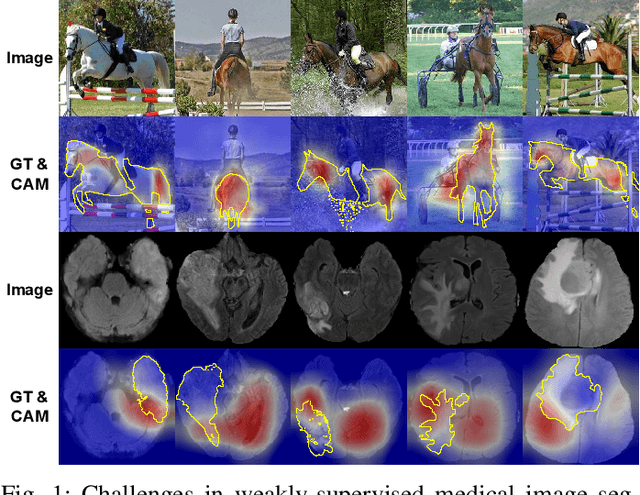
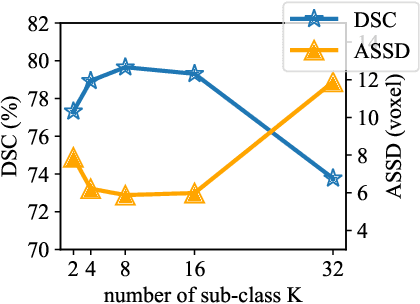
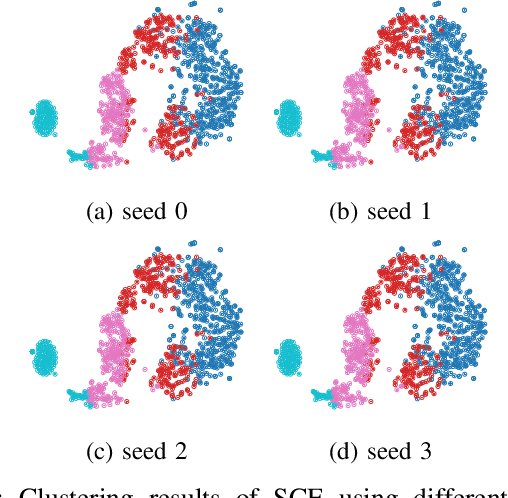
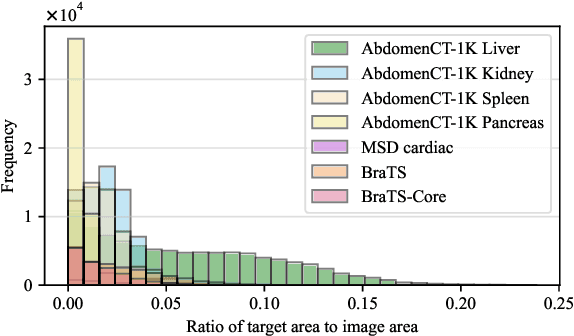
Abstract:We have witnessed remarkable progress in foundation models in vision tasks. Currently, several recent works have utilized the segmenting anything model (SAM) to boost the segmentation performance in medical images, where most of them focus on training an adaptor for fine-tuning a large amount of pixel-wise annotated medical images following a fully supervised manner. In this paper, to reduce the labeling cost, we investigate a novel weakly-supervised SAM-based segmentation model, namely WeakMedSAM. Specifically, our proposed WeakMedSAM contains two modules: 1) to mitigate severe co-occurrence in medical images, a sub-class exploration module is introduced to learn accurate feature representations. 2) to improve the quality of the class activation maps, our prompt affinity mining module utilizes the prompt capability of SAM to obtain an affinity map for random-walk refinement. Our method can be applied to any SAM-like backbone, and we conduct experiments with SAMUS and EfficientSAM. The experimental results on three popularly-used benchmark datasets, i.e., BraTS 2019, AbdomenCT-1K, and MSD Cardiac dataset, show the promising results of our proposed WeakMedSAM. Our code is available at https://github.com/wanghr64/WeakMedSAM.
Text and Image Are Mutually Beneficial: Enhancing Training-Free Few-Shot Classification with CLIP
Dec 16, 2024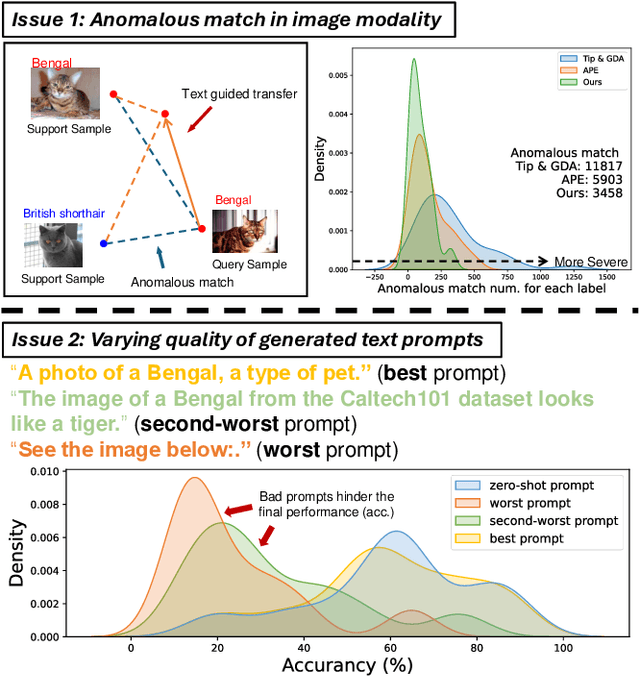
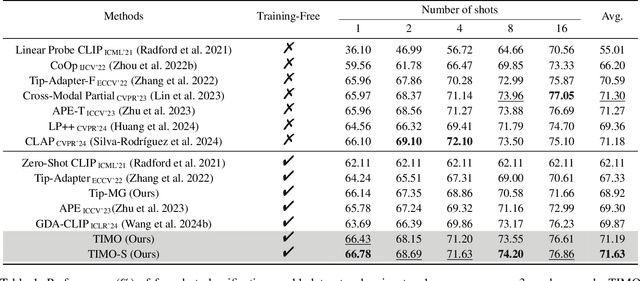
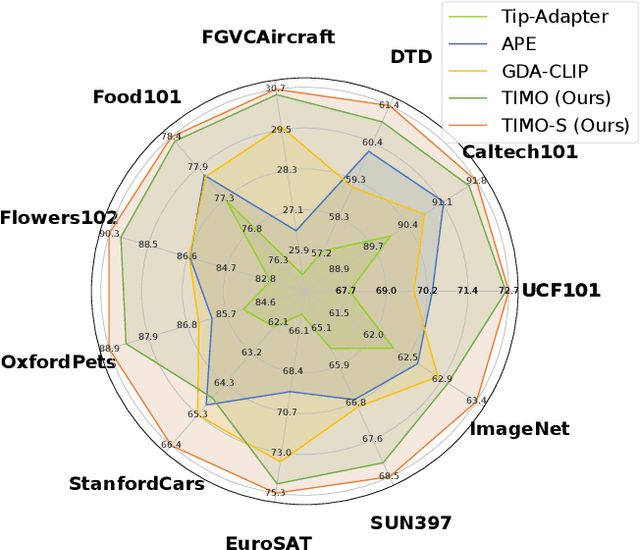

Abstract:Contrastive Language-Image Pretraining (CLIP) has been widely used in vision tasks. Notably, CLIP has demonstrated promising performance in few-shot learning (FSL). However, existing CLIP-based methods in training-free FSL (i.e., without the requirement of additional training) mainly learn different modalities independently, leading to two essential issues: 1) severe anomalous match in image modality; 2) varying quality of generated text prompts. To address these issues, we build a mutual guidance mechanism, that introduces an Image-Guided-Text (IGT) component to rectify varying quality of text prompts through image representations, and a Text-Guided-Image (TGI) component to mitigate the anomalous match of image modality through text representations. By integrating IGT and TGI, we adopt a perspective of Text-Image Mutual guidance Optimization, proposing TIMO. Extensive experiments show that TIMO significantly outperforms the state-of-the-art (SOTA) training-free method. Additionally, by exploring the extent of mutual guidance, we propose an enhanced variant, TIMO-S, which even surpasses the best training-required methods by 0.33% with approximately 100 times less time cost. Our code is available at https://github.com/lyymuwu/TIMO.
START: A Generalized State Space Model with Saliency-Driven Token-Aware Transformation
Oct 21, 2024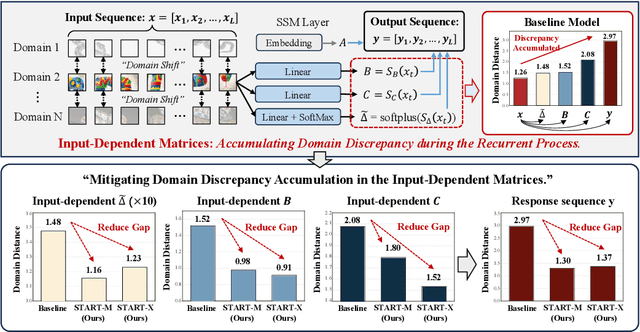
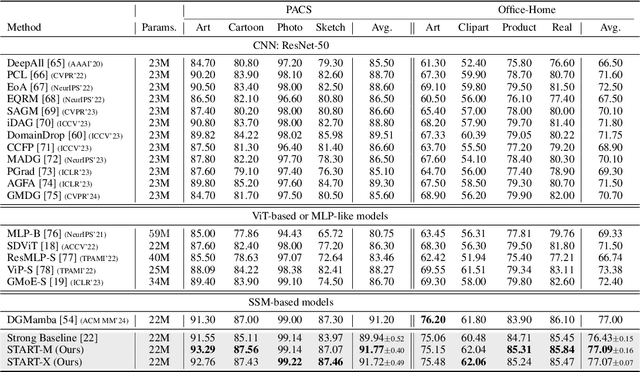
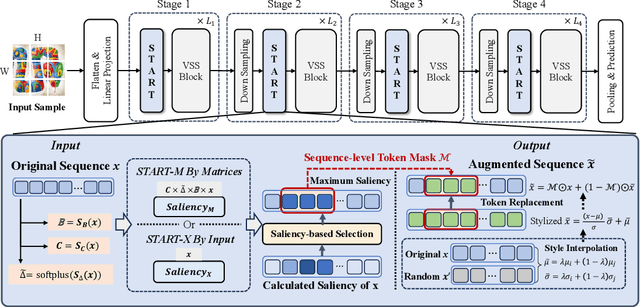
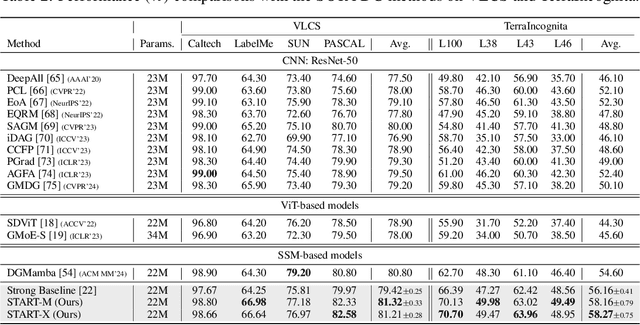
Abstract:Domain Generalization (DG) aims to enable models to generalize to unseen target domains by learning from multiple source domains. Existing DG methods primarily rely on convolutional neural networks (CNNs), which inherently learn texture biases due to their limited receptive fields, making them prone to overfitting source domains. While some works have introduced transformer-based methods (ViTs) for DG to leverage the global receptive field, these methods incur high computational costs due to the quadratic complexity of self-attention. Recently, advanced state space models (SSMs), represented by Mamba, have shown promising results in supervised learning tasks by achieving linear complexity in sequence length during training and fast RNN-like computation during inference. Inspired by this, we investigate the generalization ability of the Mamba model under domain shifts and find that input-dependent matrices within SSMs could accumulate and amplify domain-specific features, thus hindering model generalization. To address this issue, we propose a novel SSM-based architecture with saliency-based token-aware transformation (namely START), which achieves state-of-the-art (SOTA) performances and offers a competitive alternative to CNNs and ViTs. Our START can selectively perturb and suppress domain-specific features in salient tokens within the input-dependent matrices of SSMs, thus effectively reducing the discrepancy between different domains. Extensive experiments on five benchmarks demonstrate that START outperforms existing SOTA DG methods with efficient linear complexity. Our code is available at https://github.com/lingeringlight/START.
 Add to Chrome
Add to Chrome Add to Firefox
Add to Firefox Add to Edge
Add to Edge